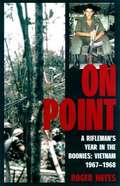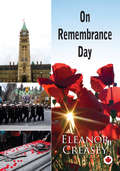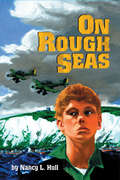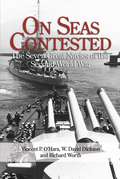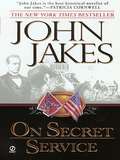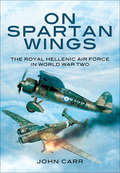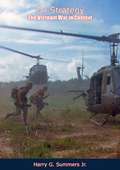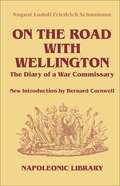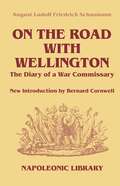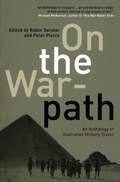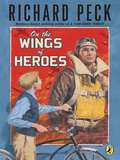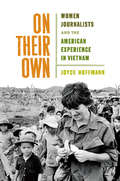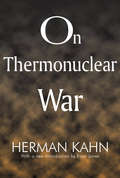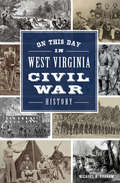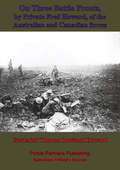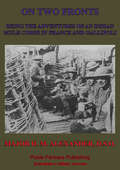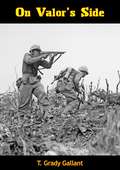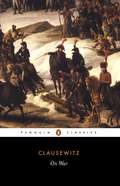- Table View
- List View
On Point (Out Of Uniform Ser. #3)
by Annabeth AlbertNever fall for your best friend... Pushing thirty, with his reenlistment looming, decorated navy sniper Maddox Horvat is taking a long look at what he really wants in life. And what he wants is Ben Tovey. It isn't smart, falling for his best friend and fellow SEAL, but ten years with Ben has forged a bond so intimate Maddox can't ignore it. He needs Ben by his side forever-heart and soul. Ben admits he likes what he's seen-his friend's full lower lip and the perfect muscles of his ass have proved distracting more than once. But Ben's still reeling from a relationship gone to hell, and he's not about to screw up his friendship with Maddox, too. Until their next mission throws Ben and Maddox closer together than ever before, with only each other to depend on. Now, in the lonely, desperate hours awaiting rescue, the real challenge-confronting themselves, their future and their desires-begins. Man to man, friend to friend, lover to lover. This is book three in the Out of Uniform series. Don't miss the first two books: Book 1: Off Base Book 2: At Attention This book is approximately 78,000 words One-click with confidence. This title is part of the Carina Press Romance Promise: all the romance you're looking for with an HEA/HFN. It's a promise!
On Political War
by Paul A. Smith Jr.Warfare is often defined as the employment of military means to advance political ends. So understood, conventional warfare may be seen as one military means to ensure national survival and pursue national advantage. Another, more subtle, means—political warfare—uses images, ideas, speeches, slogans, propaganda, economic pressures, even advertising techniques to influence the political will of an adversary.Through political warfare, a nation can express its vision of the world as well as its sense of what particular role it intends to play within the international setting. Major political warfare campaigns often target an adversary’s populace as a whole. In an effort to isolate an adversary, they may address that adversary’s allies and neutral or nonaligned nations as well. And, working through client states, a nation may influence a broad range of events without actually involving itself directly in conventional armed conflict.In this study of political warfare in the Western world, Paul A. Smith, Jr, traces the development of political warfare since antiquity. His grasp of history, literature, art, politics, and armed conflict comprehensively informs his contention that political warfare is often as crucial to national survival as the massing of great land, sea, and air power. Now that the Soviets’ 40-year campaign of aggression, intimidation, and hegemony is in apparent retreat and the world is increasingly beset by low-intensity conflict and struggles for economic domination, political warfare will be at the forefront of our national security agenda.
On Posthuman War: Computation and Military Violence
by Mike HillTracing war&’s expansion beyond the battlefield to the concept of the human being itself As military and other forms of political violence become the planetary norm, On Posthuman War traces the expansion of war beyond traditional theaters of battle. Drawing on counterinsurgency field manuals, tactical manifestos, data-driven military theory, and asymmetrical-war archives, Mike Hill delineates new &“Areas of Operation&” within a concept of the human being as not only a social and biological entity but also a technical one.Delving into three human-focused disciplines newly turned against humanity, OnPosthuman War reveals how demography, anthropology, and neuroscience have intertwined since 9/11 amid the &“Revolution in Military Affairs.&” Beginning with the author&’s personal experience training with U.S. Marine recruits at Parris Island, Hill gleans insights from realist philosophy, the new materialism, and computational theory to show how the human being, per se, has been reconstituted from neutral citizen to unwitting combatant. As evident in the call for &“bullets, beans, and data,&” whatever can be parted out, counted, and reassembled can become war materiel. Hill shows how visible and invisible wars within identity, community, and cognition shift public-sphere activities, like racial identification, group organization, and even thought itself, in the direction of war. This shift has weaponized social activities against the very notion of society. On Posthuman War delivers insights on the latest war technologies, strategies, and tactics while engaging in questions poised to overturn the foundations of modern political thought.
On Remembrance Day
by Eleanor CreaseyAn exploration of Canadian Remembrance Day history, customs, and traditions. Who are the people who offered their lives in war? Why do we remember them? How do we honour their memory? For children learning about remembrance and the human toll of war, there can be hard questions to answer. This book is meant to answer the questions kids ask about Remembrance Day and to explain how and why we honour the men and women who have served our country. Canada has developed unique ways of honouring and demonstrating respect for its war dead and veterans. Through every generation there are Canadian families who have lost loved ones to international conflict and war. On Remembrance Day presents the origins, traditions, and customs of Canada’s Remembrance Day in a fashion that is engaging and easy to read.
On Rough Seas
by Nancy HullAt 14, Alec knows what he wants to be: a seaman. Instead of working at his family's inn, he prefers roaming through the busy streets and docks of Dover. When the captain of the Britannia, one of the fishing vessels in the Channel, asks him to be a galley boy, he seizes the opportunity in spite of his father's objections. On his first day at sea, he weathers a severe storm similar to the one that took the life of his cousin and best friend, Georgie, months earlier. Alec still feels guilty for having not been able to save Georgie. England is at war with Germany, and soon Alec is doing more than swabbing the deck and handling the ropes of the fishing vessel. He wonders why shadowy figures are disappearing into the tunnels under the old stone castle and who the special soldiers being billeted at the inn are. Then comes terrible news: hundreds of thousands of British forces are trapped on the beach at Dunkirk. All ships in the Channel, large and small, are ordered to undertake a massive evacuation. Alec's transformation from galley boy to courageous seaman is a riveting journey in this dramatic debut novel.
On Seas Contested
by Vincent P. OharaAn international team of naval historians and scholars has pooled their expertise for this definitive reference on how the great navies of World War II were organized and how they trained, operated, and fought. They provide a point-by-point evaluation on the inner workings of the navies of the United States, the United Kingdom and Commonwealth, Japan, Germany, Italy, France, and the Soviet Union. Each navy has its own chapter, which covers such key features as weaponry, training, logistics, and doctrine. In bringing together data buried in specialized works in various languages, the authors deliver a fresh, multinational view of the naval war.
On Secret Service
by John JakesIt is America 1861 and North and South have never seemed further apart: the threat of civil war hangs heavy in the air. . . For Lon Price, the issue is simple. He has inherited from his Methodist father both a burning sense of right and wrong, and a desire to see an end to slavery. So much so that he is prepared to resign from the Pinkerton police agency to fight for the North. But his departure is not necessary, for the federal government is well aware of the agency's work, and in Lon they see a primie candidate for secret service. . . Margaret Miller is part of a family that prides itself on supporting the South: her father Calhoun is owner of the secession supporting Baltimore Independent; her brother Cicero has similar views, though the circles he moves in are considerably less law-abiding. When Calhoun is killed by a Yankee bullet, Margaret becomes as determined as Lon to uphold the ideals of her father. . . www. johnjakes. com
On Spartan Wings: The Royal Hellenic Air Force in World War Two
by John CarrThis WWII history chronicles the courageous but ill-prepared Greek air force from the Battle of Greece to the Battle of El Alamein and beyond. On October 28th, 1940, when Greece was invaded by Mussolini&’s Italy, the Royal Hellenic Air Force was severely outgunned. Without warning, the RHAF&’s paltry fleet was pitted against the much larger and more advanced Regia Aeronautica, whose pilots had recently honed their skills in the Spanish Civil War. Though the British Royal Air Force gave whatever assistance it could, the aerial war was unequal from the beginning. Greek flying aces such as Marinos Mitralexis managed to keep morale high. But even as individual pilots and crewmembers fought valiantly, the RHAF was seriously depleted by the end of 1940. The end came in April 1941 when Hitler sped to the rescue of Italy&’s faltering forces. The Luftwaffe overwhelmed what was left of the RHAF, leaving a single mira, or squadron, to escape intact to Egypt. Out of this small squadron grew three full mirai, whose pilots, now equipped with modern aircraft, played a decisive part in the Allied victory at El Alamein. Until Greece was liberated in October 1944, the RHAF units ranged over targets in the Aegean Sea, Italy and Yugoslavia. In this comprehensive history, John Carr draws on meticulous research and firsthand accounts to shed light on the skill and heroism of the Greek airmen and their contributions to WWII air warfare.
On Strategy: A Critical Analysis of the Vietnam War
by Harry G. SummersSummer's inspired analysis of America's war in Vietnam answers the most pressing questions remaining from that terrible conflict more than a decade before Robert McNamara's painful admissions.
On Strategy: The Vietnam War in Context
by Harry G. Summers Jr."This important book is one man's critical analysis of American strategy in the Vietnam war. That man, Harry Summers, is an active Army officer who began professional life as an enlisted soldier, knows personally the bayonet-point reality of war, and has thought widely about strategic issues. His commitment to the nation and Army he serves is unstinting." "... Colonel Summers has focused his attention at that point in the strategic continuum where military strategy and national policy come together. His main thesis is that a lack of understanding of the relationship between military strategy and national policy caused us to exhaust our will and endurance against a secondary enemy, the guerrilla movement in South Vietnam, instead of focusing our military efforts to check North Vietnamese expansion in support of our national policy of containment. ..." DeWitt C. Smith, Jr. Lieutenant General, United States Army (Retired)
On The Old Plantation Reminiscences of his Childhood
by J. G. ClinkscalesA white Southerner's sympathetic memoir of plantation life. John George Clinkscales (1855-1942) was the 11th of 12 children of the owner of "Broadway," a 1,200 acre plantation in the Abbeville District of South Carolina, home to 110 slaves. Originally published in 1916 in Spartanburg, South Carolina.“John George Clinkscales was born in 1855 in Abbeville, South Carolina, and grew up on his father's plantation. He graduated from Wofford College in Spartanburg, South Carolina in 1876 and taught in county schools for several years before accepting a position at Williamston Female College in Anderson County, South Carolina in 1881. Clinkscales was elected superintendent of education in Anderson and served in that capacity for four years before returning to teaching. In 1914, Clinkscales campaigned for governor, running on a platform advocating compulsory education. Although he did not win, his strong showing led the legislature to pass the first compulsory education law in South Carolina. Clinkscales wrote two books: a novel, How Zach Came to College (1907), and his memoir, On the Old Plantation (1916). Both were widely read in the South.In his book, On the Old Plantation, Clinkscales records his memories of life on his father's plantation. He hoped that his book would serve as a counterargument to Harriet Beecher Stowe's negative depiction of slavery in Uncle Tom's Cabin. To that end, he began his memoir with a story of his father's foreman, "Unc' Essick" that portrays his father's benevolence towards his slaves. He also included stories about the character of particular slaves, written in dialect. Clinkscales recounts his childhood pranks, adventures, and school experiences, which combine to present his happy memories of antebellum South Carolina.”-Harris Henderson
On The Road To Kut, A Soldier’s Story Of The Mesopotamian Campaign [Illustrated Edition]
by Anon “black Tab”Includes 56 original illustrations and a map of the area.Our anonymous author was part of the 6th Poona Division, Indian Army, the first of the British Empire's forces to be deployed to Mesopotamia during the First World War. Fighting and marching through sweltering temperatures forced much inactivity on the British and Indian troops as much as their Turkish and Arab opponents. The author in his irreverent style remarked: "From 6 a.m. to 9 a.m. it was hot. From 9 a.m. to 12 damned hot. From 12 to 5.30 much too damned hot." The campaigning seasons in this part of the world were hot, difficult and fraught with ambush and disease. Black Tab's struggles and travails as he marches with his comrades to the relief of Kut are punctuated with witty asides, and amusing vignettes, maintaining spirits in the face of adversity.An interesting memoir from an often forgotten campaign.
On The Road With Wellington: The Diary of a War Commissary in the Peninsular Campaigns (The Napoleonic Library #Vol. 34)
by August Ludolf SchaumannAs a classic work and out of print for many years, August Schaumann''s diaries provide a graphic and vivi d account of campaigning life during the Peninsular Wars.
On The Road With Wellington: The Diary of a War Commissary in the Peninsular Campaigns (The Napoleonic Library)
by August Ludolf SchaumannAs a classic work and out of print for many years, August Schaumann''s diaries provide a graphic and vivi d account of campaigning life during the Peninsular Wars.
On The Trail of Grant and Lee
by Frederick Trevor HillAn examination of the lives of Ulysses S. Grant and Robert E. Lee
On The War-path: An Anthology of Australian Military Travel
by Peter Pierce Robin GersterThis important anthology reveals the many ways in which going to war has formed a cultural bridge between Australia and the world. From the Sudan in 1885 to Afghanistan in 2001, the connection of war to travel is illustrated in the observations of writers as varied as 'Banjo' Paterson, George Johnston, Nancy Wake, John Pilger, Lily Brett and Peter Weir. Selecting writings from combatants abroad as well as the reflections of sightseers who travel to foreign battlefields and war sites, Robin Gerster and Peter Pierce reveal how the experience of war has both broadened and refined (and sometimes distorted) Australian views of the world. Their lively collection crosses the boundaries between literature, literary criticism, travel writing, war writing and cultural commentary.
On The Wings of Heroes
by Richard PeckDavy Bowman's brother and their dad hung the moon. Dad looks forward to Halloween more than a kid, and Davy's brother, Bill, flies B-17s. Davy adores these two heroes and tries his best to follow their lead, especially now. World War II has invaded Davy's homefront boyhood. There's an air raid drill in the classroom, and being a kid is an endless scrap drive. Bill has joined up, breaking their dad's heart. It's an intense, confusing time, and one that will invite Davy to grow up in a hurry. Still, Richard Peck is a master of comedy, and even in this novel of wartime uncertainty, he infuses his tale with humor: oddballs and rascals and boyhood misadventures alongside the poignant moments. This is one of Richard Peck's very finest novels-a tender, unforgettable portrait of the World War II homefront and a family's love. .
On Their Own: Women Journalists and the American Experience in Vietnam
by Joyce HoffmanOver three hundred women, both print and broadcast journalists, were accredited to chronicle America’s activities in Vietnam. Many of those women won esteemed prizes for their reporting, including the Pulitzer, the Overseas Press Club Award, the George Polk Award, the National Book Award, and the Bancroft Prize for History. <P><P>Tragically, several lost their lives covering the war, while others were wounded or taken prisoner. In this gripping narrative, veteran journalist Joyce Hoffmann tells the important yet largely unknown story of a central group of these female journalists, including Dickey Chapelle, Gloria Emerson, Kate Webb, and others. Each has a unique and deeply compelling tale to tell, and vivid portraits of their personal lives and professional triumphs are woven into the controversial details of America’s twenty-year entanglement in Southeast Asia.
On Thermonuclear War
by Evan Jones Herman KahnOn Thermonuclear War was controversial when originally published and remains so today. It is iconoclastic, crosses disciplinary boundaries, and finally it is calm and compellingly reasonable. The book was widely read on both sides of the Iron Curtain and the result was serious revision in both Western and Soviet strategy and doctrine. As a result, both sides were better able to avoid disaster during the Cold War. The strategic concepts still apply: defense, local animosities, and the usual balance-of-power issues are still very much with us. Kahn's stated purpose in writing this book was simply: "avoiding disaster and buying time, without specifying the use of this time." By the late 1950s, with both sides H-bomb-armed, reason and time were in short supply. Kahn, a military analyst at Rand since 1948, understood that a defense based only on thermonuclear arnaments was inconceivable, morally questionable, and not credible.The book was the first to make sense of nuclear weapons. Originally created from a series of lectures, it provides insight into how policymakers consider such issues. One may agree with Kahn or disagree with him on specific issues, but he clearly defined the terrain of the argument. He also looks at other weapons of mass destruction such as biological and chemical, and the history of their use. The Cold War is over, but the nuclear genie is out of the bottle, and the lessons and principles developed in On Thermonuclear War apply as much to today's China, Russia, Iran, and North Korea as they did to the Soviets.
On This Day in West Virginia Civil War History (Civil War Series)
by Michael B. GrahamWest Virginia is the only state formed by seceding from a Confederate state. And its connections to the Civil War run deep. One day at a time, award-winning historian Michael Graham presents intriguing, event-driven anecdotes and history related to the state. On July 11, 1861, a Union force attacked 1,300 Confederate troops camped at Rich Mountain in a renowned battle. Confederate guerrillas raided Hacker's Creek on June 12, 1864. Find little-known facts about the Battles of Droop Mountain, Carnifex Ferry, Harpers Ferry, Shepherdstown and a whole host of others. Read a story one day or month at a time. Celebrate an entire year of Civil War history in the Mountain State.
On Three Battle Fronts, By Private Fred Howard, Of The Australian And Canadian Forces
by Frederick Thomas Rowland HowardThere are many tales of soldiers fighting under the colours of an adopted nation; few stories are as fantastic as that of the Australian Frederick Howard. A keen sportsman and adept at the ways of the Australian "bush" the coming of the First World War gave him a jolt out of a meandering existence. With his twin and also his younger brother he sailed with his fellow Anzacs to the training in the Egyptian desert and then on to the hellish Gallipoli Peninsula. He was invalided home following wounds in Gallipoli, this did not faze the author who travelled all the way to Canada to enlist once again, This time finding himself in the 11th Canadian mounted rifles and under the adopted Maple Leaf he faced the Germans on the Somme in 1916 and at the success at Vimy Ridge before his indomitable military career was cut short by wounds sustained from a German shell.Despite recounting the danger as the shells and bullets whizzed and exploded around him, he relates anecdotes of his comrades and all of the wit and humour of an Australian; such as referring as his spell in hospital as time in a health resort!Highly recommended memoir.Author -- Frederick Thomas Rowland HowardText taken, whole and complete, from the edition published in New York, Vechten Waring company, 1918.Original Page Count - 177 pages
On Two Fronts - Being The Adventures Of An Indian Mule Corps In France And Gallipoli
by Major Heber Maitland AlexanderMen from all around the far reaches of the British Empire flooded into the ranks of the British army for the titanic struggle against Germany and her allies during the First World War. Ghurkhas from Nepal, Men of the Punjab, Rajputs, Dogras and Pathans volunteered to fight in the Indian regiments destined for service across the wide oceans in Europe. The men found warm comradeship with the Tommies who fought beside them, cold climates in Flanders and Belgium, and hellishly hot fighting against the enemy.Major Maitland was an officer in the Indian Army attached to the supply corps bringing vital arms, ammunition and food to the front-line. The job was certainly not a sinecure as the supply depots were often not out of range of the enemy's guns, particularly at Gallipoli. He tells his story with great detail, probably based on a diary or notes that he took at the time. His book is particularly interesting regarding the hellish conditions at Gallipoli - in fact, so interesting that the official Australian Government Anzac site quotes from his book.Essential reading.
On Valor’s Side
by T. Grady GallantFrom the initial rigors of Parris Island to actual combat conditions at Guadalcanal—here is an enlisted man’s true, firsthand account of what it was like to be a Marine during World War II. Here are the fears, the moments of triumph and joy, the gamut of emotions in those facing danger and death on the battlefield. Here is the true story of a long, cruel, holding operation…fought with too little equipment and too few men.Avoiding overdose horror themes, bedroom scenes, and needless profanity, T. Grady Gallant reveals the innermost thoughts and experiences of a band of rough and rugged men—the men of the First Division, Fleet Marine Force, who invaded Guadalcanal and won for America her first land victory of World War II.“A great book”—Leon Uris“A fine, rare book”—Burke Davis“A book all Marines will enjoy”—Robert Sherrod
On War
by Carl ClausewitzWriting at the time of Napoleon's greatest campaigns, Prussian soldier and writer Carl von Clausewitz created this landmark treatise on the art of warfare, which presented war as part of a coherent system of political thought.In line with Napoleon's own military actions, he illustrated the need to annihilate the enemy and make a strong display of one's power in an 'absolute war' without compromise. But he was also careful to distinguish between war and politics, arguing that war could only be justified when debate was no longer adequate, and that if undertaken, its aim should ultimately be to improve the wellbeing of the nation.

